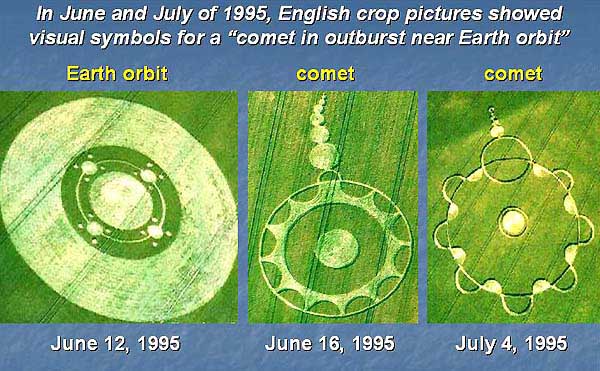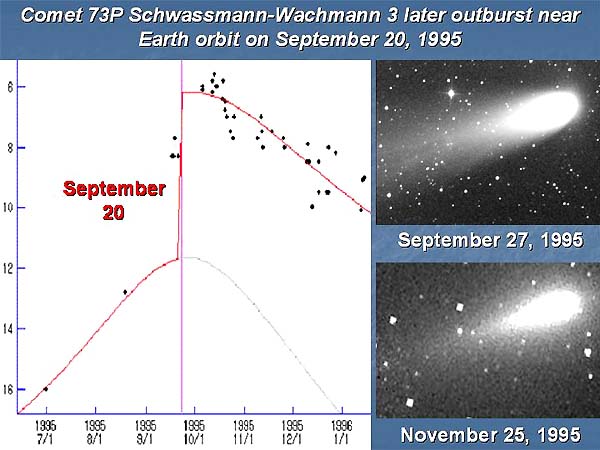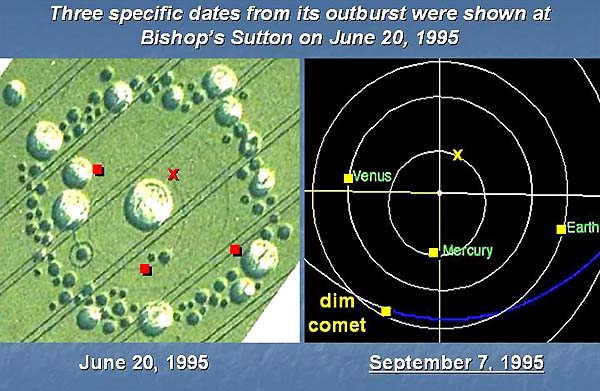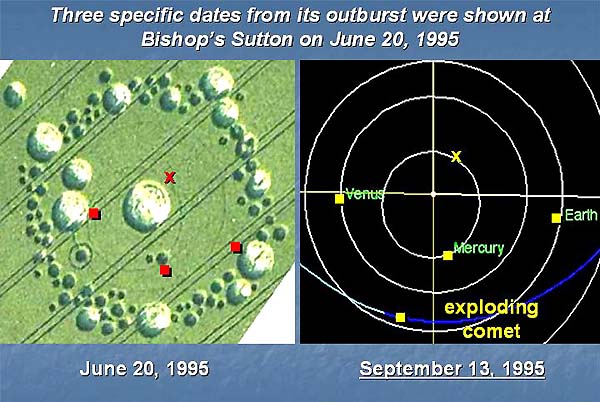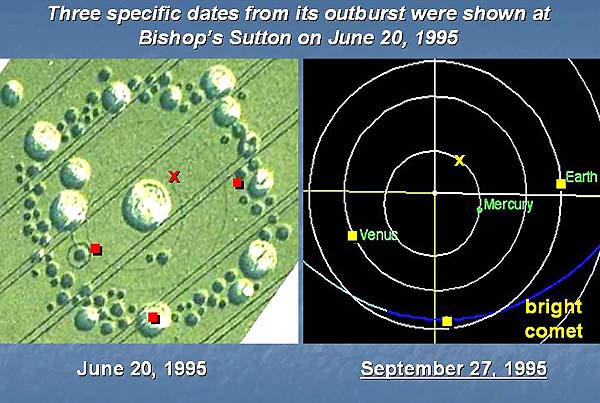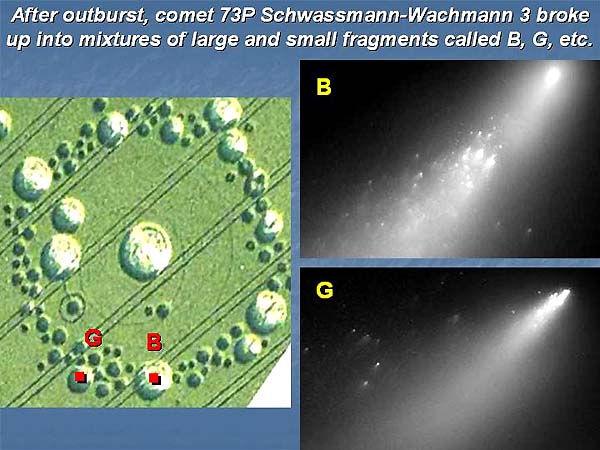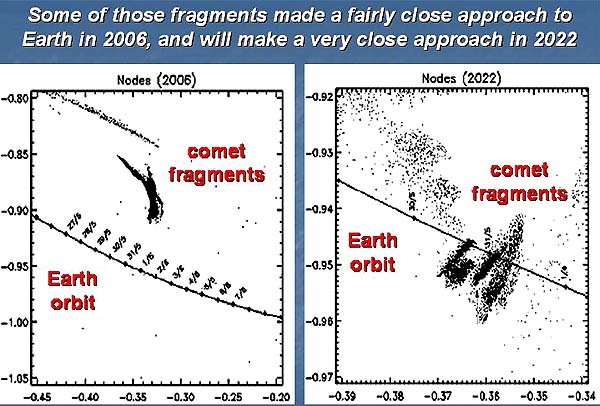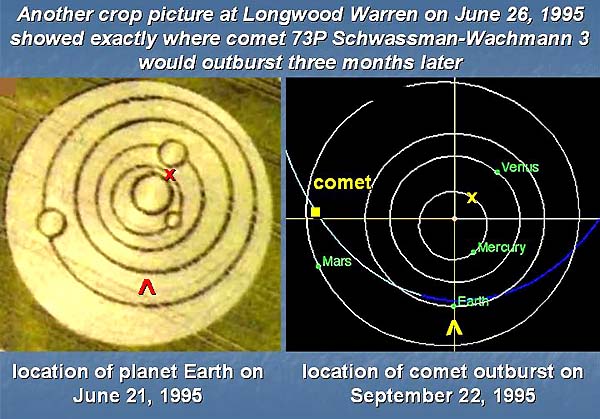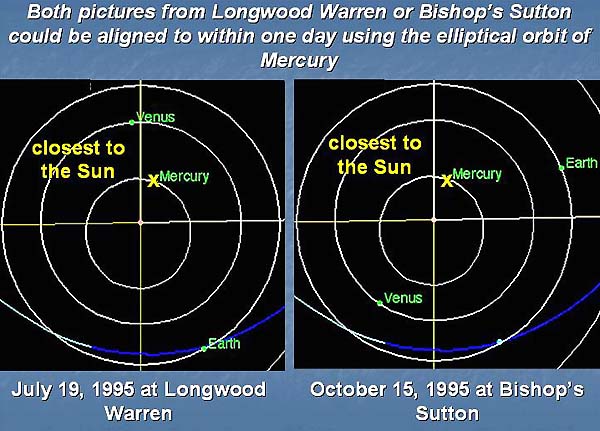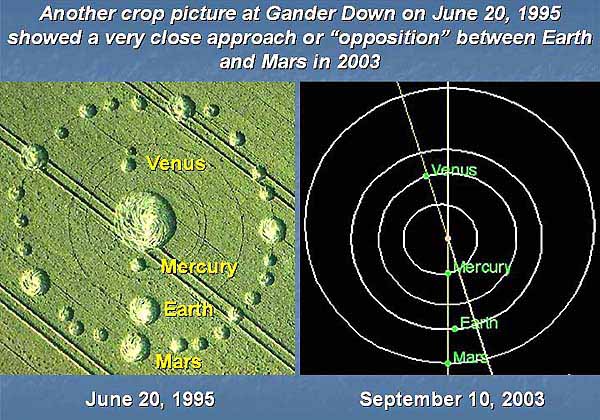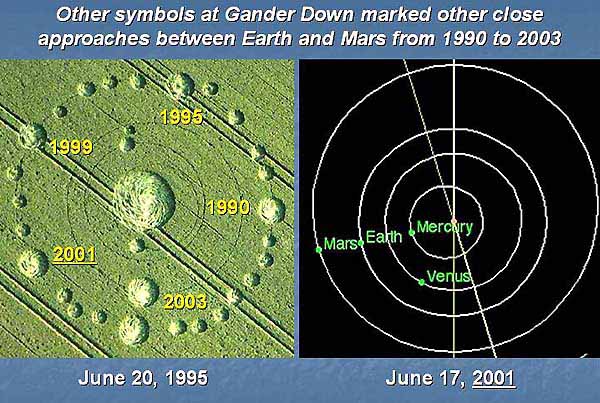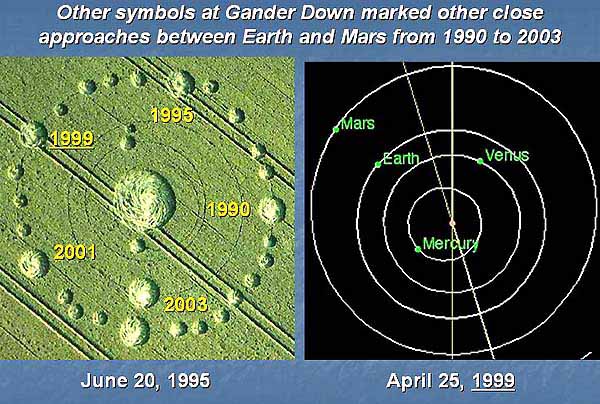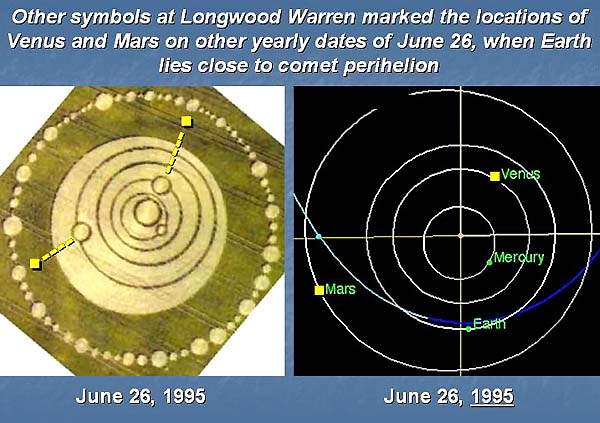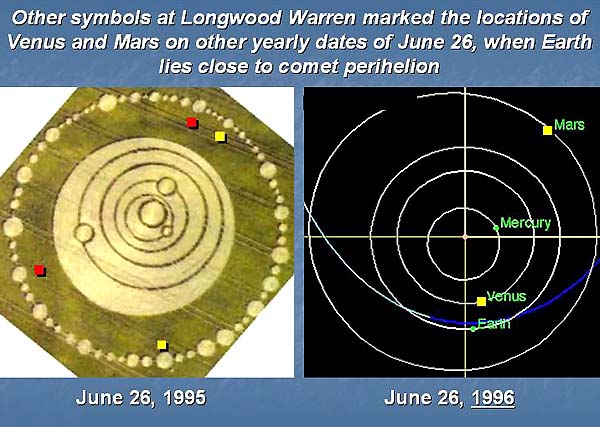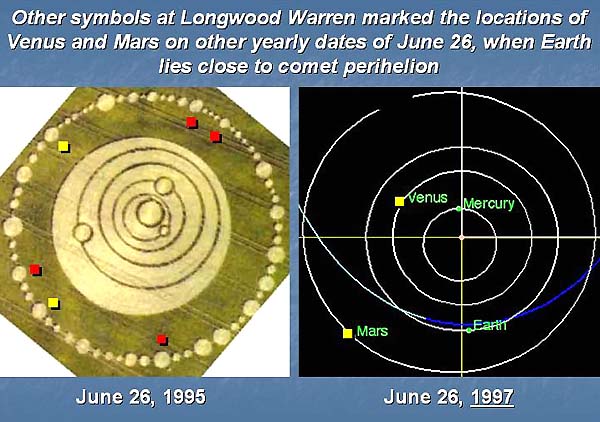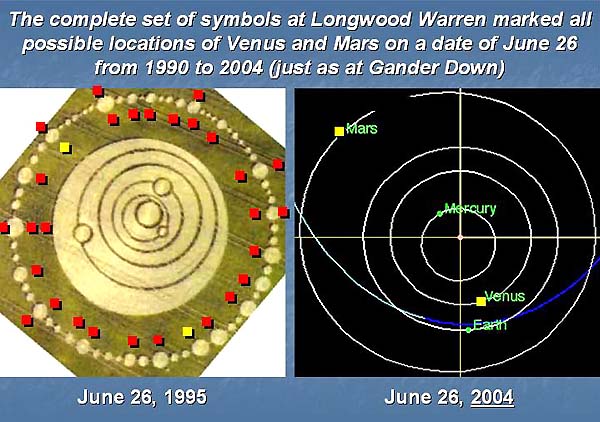|
Another example of future prediction in crops: the outburst of comet 73P Schwassmann-Wachmann 3 in September 1995 was shown three months earlier in English crop pictures from June or July
Two months ago, we learned that a
whole series of crop pictures from the summer of 2005
had predicted the outburst of comet 17P Holmes on
October 24, 2007 in a highly convincing fashion: see
www.cropcircleconnector.com/anasazi/time2007g.html or
www.cropcircleconnector.com/anasazi/time2007h.html. We
were supplied with: (a) visual symbols of that exploding
comet, (b) artistic representations, (c) planetary
diagrams, and (d) astronomical or mathematical codes for
specific calendar dates.
Here I will show a second example of
future prediction in crops, where certain pictures from
June or July of 1995 can be seen in retrospect to have
accurately predicted the outburst of comet 73P
Schwassman-Wachmann 3 in September 1995, which was three
months later. I commented briefly on that
subject earlier (see
www.cropcircleconnector.com/anasazi/longwoodwarren2006.html),
but without nearly as much convincing detail as will be
presented below.
Simple visual images were
shown in June and July of 1995 for "a comet in outburst
near Earth orbit"
In June and July of 1995, a series of
striking visual images were shown in English crops:
The first image appeared at Telegraph
Hill on June 12, 1995 (above left), and was simply their
astronomical symbol for "planet Earth in orbit about the
Sun" (see
www.cropcircleconnector.com/anasazi/time2007f.html).
The next two images appeared at Danebury on June 16,
1995 (above center) or Cheesefoot Head on July 4, 1995
(above right), and were clearly meant to represent
"exploding comets", by comparison to another set of
cometary pictures shown in 1994 (see www.cropcircleconnector.com/Millennium/scorpiushour.html).
All three pictures when studied
together would seem to signify "an exploding comet near
Earth orbit". Modern astronomers usually use the term
"outburst" to describe how an icy comet may explode,
when it approaches the heat of the Sun.
Comet 73P
Schwassman-Wachmann 3 later outburst on September 20,
1995
In fact, a major comet did explode or
outburst just three months after those crop pictures
appeared, and very close to Earth orbit. As shown below,
comet 73P Schwassmann-Wachmann 3 outburst on Septermber
20, 1995, and quickly increased in brightness or
astronomical magnitude (a logarithmic scale) from 13 to
6:
That comet could not be seen clearly in Earth
telescopes until around Septermber 27, because it was
lost in the glare of the Sun. All observations prior to
that date had to be made by radio waves. But good visual
photographs were taken from late September until
November 1995 (see above), and showed clearly a
bright comet with a long tail
When would it
happen? Three specific dates were provided at Bishop's
Sutton on June 20, 1995
Simple visual images are fine, but
did those crop artists provide us with anything more
substantial, to prove that they knew about the
near-future explosion of comet 73P Schwassmann-Wachmann
3 three months before it happened? Yes, they did; but in
order to understand their calendar-dated codes, first we
need to define three specific dates which marked
key steps in that cometary outburst or explosion:
"Comet 73P Schwassmann-Wachmann 3
was seen by K. Kinoshita on August 19, 1995 at magnitude
13, but then something happened. Astronomers using the
Nancay Radio Telescope detected an increase in hydroxyl
emissions on September 8. Those emissions continued to
increase through September 13. By September 17, the
comet had moved far enough away from the Sun to permit
visual observations, and its brightness was found to be
magnitude 8. By the beginning of October, several
observers reported that it had increased in brightness
to magnitude 6." (see
http://cometography.com/pcomets/073p.html).
The three specific dates would therefore be: (i) September 7-8, 1995 (start of outburst, dim comet); (ii) September 13, 1995 (end of outburst, exploding comet), and (iii) late September or early October (visual observations, bright comet). In fact, our crop artist friends showed us all three of those dates in a cleverly overlapping single picture, which appeared at Bishop's Sutton on June 20, 1995. The first date of September 7-8 (start of outburst, dim comet) was designated in a unique fashion by three orbital symbols for the planets Venus, Mercury and Earth:
The comet cannot be seen yet on
this early date, because it has only started to
explode. Another small symbol "x"
indicates a close approach between Mercury and the
Sun, which may be used to help date the picture more
accurately.
A second date of
September 13 (end of outburst,
exploding comet) was likewise designated in a unique
fashion by two additional orbital symbols for the
fast-moving planets Venus and Mercury, while keeping
the same symbol for slow-moving Earth:
The comet still cannot be seen
yet on this intermediate date, because it remains in
the glare of the Sun as seen from Earth. It can only
be studied by radio waves.
A third date of
September 27 (visual observations,
bright comet) was designated by two additional
orbital symbols for Venus and Earth, as well as by a
third orbital symbol for the comet (bottom of
picture), which now has become bright enough to be
seen from Earth:
The new symbol for Venus has been
drawn with another circle inscribed around it, as if
to say, "This is the earliest date when you will be
able to see that exploded comet through an ordinary
light telescope, after it moves away from the glare
of the Sun." All observations prior to September 20
were made on the Nancay Radio Telescope, which
detects radio waves rather than light (see
http://en.wikipedia.org/wiki/Nan%C3%A7ay_Radio_Telescope or
www.obs-nancay.fr/nrt/a_rt.htm).
Comet 73P Schwassmann-Wachmann 3 later broke up into mixtures of large or small fragments (as also shown at Bishop's Sutton) By late September or October of 1995, comet 73P Schwassmann-Wachmann 3 had begun to break up into many different mixtures of large and small fragments. Those were also shown at Bishop's Sutton on June 20, 1995:
They were portrayed in
crops (above left) as completely filling Earth
orbit, but that may be just artistic license. Its
two brightest mixtures of fragments "B" and G" were
later photographed by the Hubble telescope when they
passed close to Earth in May of 2006 (above right).
"Those cometary fragments passed Earth in May of 2006 at a distance of just 12 million km (0.08 A.U.). When the same comet passed close to Earth in 1930, there were as many as 100 meteors per minute. In 2022, those comet fragments will pass even closer to Earth than in 2006, but it is currently unknown what their exact trajectory will be." (see http://en.wikipedia.org/wiki/Comet_73P or www.space.com/scienceastronomy/060510_comet_spitzer.html). Comet 73P Schwassman-Wachmann 3 orbits the Sun once every 5.3 years. Its closest approaches to the Sun ("perihelions") have been on past dates of May 19, 1990, September 22, 1995, January 27, 2001 and June 7, 2006. Yet that comet only approaches planet Earth occasionally, when the two separate orbits of those astronomical bodies happen to coincide. How close will we come to comet 73P Schwassman in 2022 versus 2006? I found an excellent paper on the subject by P. Wiegert et al. in Monthly Notices of the Royal Astronomical Society 361, 368 (2005), and have reproduced two of their figures below:
In 2006 (above left), the orbit of Earth came fairly close to fragmets of comet 73P Schwassman-Wachmann 3 on May 1. Yet in 2022 (above right), the orbit of Earth will pass directly through the some of the densest fragments of that comet for several days! This is a situation that we will need to watch closely as the time approaches, and more accurate orbital calculations may be made. Where would it happen? A specific location in space was shown at Longwood Warren on June 26, 1995 One of the most famous crop
pictures in the entire history of this
phenomenon appeared at Longwood Warren on June 26, 1995.
It has inspired numerous attempts at
astronomical interpretation (http://members.shaw.ca/rolfwitzsche/canada/crop_circles.html or
www.cropcircleresearch.com/articles/longwood95.html),
detailed forensic study The reason why it has inspired so much study, research and speculation is that it seems to be an important message to humans on Earth from higher intelligences elsewhere, but nobody can figure out what it means! Well, a unique answer becomes obvious once it is studied in the context of other crop pictures from the summer of 1995, and now everyone will know:
That crop picture (above left) showed three specific orbital locations for the planets Mars, Venus and Mercury, but omitted to show any orbital location for Earth. One can nevertheless figure out where "Earth" should have been located, using the JPL Near Earth Orbit website (http://neo.jpl.nasa.gov/orbits). Its three symbols for Mars, Venus and Mercury designate a unique calendar date of June 21, 1995 (above right), as does the elliptical orbit of Mercury (see below). Therefore, a symbol for "Earth" could have been drawn at the location of the red arrow shown above left, which lies direcly at the bottom of Earth's nearly circular orbit as portrayed there. So why was an orbital symbol for "Earth" omitted from Longwood Warren on June 26, 1995? It could not possibly have been because something "bad" was about to happen, since the specified calendar date of June 21, 1995 had already passed by five days! Rather, it was to call attention to the fact that planet Earth on June 21, 1995 was located precisely in space, where comet 73P Schwassman-Wachmann 3 would outburst or explode three months later in mid-September (see the yellow arrow, above right), The elliptical orbit of Mercury may be used to align both Longwood Warren and Bishop's Sutton to within one day So far we have only used the simple angular locations of Mars, Earth, Venus or Mercury to date various astronomical events, while assuming circular orbits about the Sun. But the orbit of Mercury is quite elliptical, and that provides an independent means of checking our calculations. In fact, both crop pictures from Longwood Warren or Bishop's Sutton showed such an elliptical feature clearly. If we align the elliptical orbit of Mercury with the elliptical orbit of comet 73P Schwassmann-Wachmann 3, we find perihelion dates (closest points to the Sun) for Mercury of July 19, 1995 at Longwood Warren, or October 15, 1995.at Bishop's Sutton:
Both of those dates agree with our other calculations to within one day: Mercury requires 87 days to complete one full turn about the Sun, or 22 days for one-quarter turn..At Longwood Warren on June 21, 1995, one may therefore proceed 120 degrees counter-clockwise to reach perihelion on July 19 (see above). At Bishop's Sutton on September 13, 1995, one may proceed 150 degrees counter-clockwise to reach perihelion on October 15 (see above). A series of close approaches between Earth and Mars were shown at Gander Down on June 20, 1995 Not all crop pictures from the summer of 1995 dealt with comets. One picture in particular which appeared at Gander Down on June 20, 1995 showed a quite different aspect of solar system astronomy: namely a seres of close approaches or "oppositions" between Earth and Mars spanning the years 1990 to 2003 (see www.swirlednews.com/article.asp?artID=659). Its four inner symbols showed a very close approach between Earth and Mars on September 10, 2003:
Then its outer symbols showed other close approaches between Earth and Mars on June 17, 2001,
on April 25, 1999,
or on two other dates of February 14,
1995 or December 1, 1990 (see above).
Why would those crop artists bother
to show us something so trivial? Simply because Gander
Down contained the necessary symbolic and temporal
information by which to decode the outermost parts of
Longwood Warren, which appeared six days later.
A series of angular
locations for Venus or Mars were shown in the
outermost ring of Longwood Warren on June 26, 1995
A
complete picture of Longwood Warren is shown below.
There we can see how it contains both an inner part and
an outer part. Its inner part specifies a calendar date
of June 21, 1995 by means of three orbital symbols for
the planets Mars, Venus and Mercury, as well as by an
elliptical orbit for Mercury. Its outer part shows many
different planetary symbols, two of which seemingly
align with the inner planets Venus and Mars on a
calendar date of June 26, 1995 just five days later (and
when that crop picture appeared):
On
that particular day, planet Earth came very close in
space to the perihelion location of comet 73P
Schwassmann-Wachmann 3: see the orbital diagram shown
above right. But that gives us a good idea! Could all of
those other large circles in the outermost ring of
Longwood Warren represent other angular locations for
Venus and Mars, on the same date of June 26 but in other
calendar years?
In
order to test that hypothesis, let us look next at
planetary locations on a date of June 26, 1996
(one year later): There we again find that two
more large circles from the outermost ring of Longwood
Warren match new angular locations for Venus and Mars:
The same relation also holds true for a
calendar date of June 26, 1997 (two years later):
In fact, when we calculate all possible
locations of Venus and Mars on a date of June 26 for the
years 1990 to 2004, we find an excellent match to every
large circle from the outermost ring of Longwood Warren
without exception:
On June 26 in each of those years, planet
Earth lies close in space to the perihelion location of
comet 73P Schwassman-Wachmann 3. That is why we saw a fairly
close approach between fragments of that comet and planet
Earth in May of 2006, and may expect to see an even closer
approach in 2022 (see above). The chance of that comet
impacting on Earth in 2022 still remains fairly remote,
however, just as say for a long golf shot landing on a
spacious putting green: yes, the ball did reach the green,
but will it really go into the hole and score a hole-in-one?
Probably not!
"Humans like ourselves, but
super-smart and can travel through time"
In two previous articles on this website,
I explained how a series of crop pictures from the summer of
2005 had accurately predicted the outburst of comet 17P
Holmes on October 24-25, 2007 or two years later (see www.cropcircleconnector.com/anasazi/time2007g.html or
www.cropcircleconnector.com/anasazi/time2007h.html). Now
in the present article, I have explained how a series of
crop pictures from the summer of 1995 predicted the
outburst of comet 73P Schwassmann-Wachmann 3 on
Septermber 20, 1995 or three months later.
Few if any of these "future
predictive" crop pictures could have been made by
ordinary humans who live on Earth today (it almost goes
without saying). Sometimes the detailed forensic
evidence for non-human construction of crop pictures
seems unequivocal (see for example
www.cropcircleconnector.com/ilyes/P13t.html);
but in such future-predictive cases, the logical
evidence alone would be sufficient.
Who is sending us these messages and
why? I find it very doubtful that the majority of modern
crop pictures could be made by non-human aliens (with
some exceptions, see
www.cropcircleresearch.com/articles/arecibo.html).
Alternatively, it could be that human-like
extra-terrestrials visited Earth in the distant
past, and continue to do so today. Some circumstantial
evidence links these crop pictures to a mysterious
European scientist and his colleagues who lived in the
Avebury region of England around 1000 BC, whom the
Olmecs called "Quetzalcoatl" (see
www.cropcircleconnector.com/anasazi/time2007e.html).
Other evidence links them to a long-forgotten race of
British megalith builders known as the "Tuatha de'
Danaan" who lived near Avebury around 2000 BC (see
www.cropcircleconnector.com/anasazi/sundials2007b.html).
Alexander Thom, a Professor of Engineering at
Oxford, once said that he considered the brainpower of
those legendary megalith builders to be
"somewhat superior to his own" (from Cracking the
Stone Age Code 2007 by Robin Heath).
For sure, I would agree with those
sentiments! Just look at any of the amazing crop
pictures shown above and their detailed meanings. While
showing these images to friends over Christmas, one
commented that the crop artists seem similar to a fictional
but advanced race known as "the Ancients" on a TV show
called "Stargate". Another said succinctly, "Maybe they are
humans like ourselves, but super-smart and can travel
through time?" The modern crop-circle phenomenon therefore
leads us seemingly, not only to ponder our future, but also
to question our past.
Red Collie
Appendix. A need for more
research funding in the summer of 2008 to help
document new messages in a scientific fashion
It should have become clear now to the
average reader that modern crop pictures are a "real
phenomenon". Sometimes they can even "predict the future".
Last year on July 7, 2007, Terje Toftenes with his
colleagues Winston Keech and Gary King captured on film a
huge crop-based message as it was being made at East Field
near Avebury, by some mysterious light-based energy in less
than 15 minutes:
A much clearer photograph of that same,
300-meter-long picture was taken in daylight a few hours
later:
See
www.gazetteandherald.co.uk/news/headlines/display.var.1559662.0.the_crop_circle_mystery.php or
www.bbc.co.uk/wiltshire/content/articles/2007/08/14/wilts_crop_circles_2007_feature.shtml or
www.kornsirkler.org/Sistenytt/2007/07%2007%20East%20Field/0707%20East%20Field%20eng.htm for
news reports of that event. Many of the plant stems in
that crop picture were only bent, not broken, about six
inches off the ground. Many of its "circles" appeared as
perfect circles from the air, but measured to
be "ovals" along the hilly field, thereby implying that any
projective energy had to have come from above.
Interviews with the research team are available on
www.earthfiles.com/news.php?ID=1288&category=Environment,
while evidence of an immediate British military response was
noted on
www.earthfiles.com/news.php?ID=1289&category=Environment,
Terje Toftenes, leader of the research team, later
commented:
"We are thrilled about what has
happened here, and feel the world should know that something
is going on which I just canít describe. We are very
conservative in the ways that we conduct our lives. We donít
want change, and even though we sometimes say that we are
open to change; deep down we donít want it. These phenomena
are opening a door to something that we cannot control. It
threatens our worldview. It threatens our belief systems. To
feel secure in society, you have to feel that you have
control. These crop formations tell us that governments do
not have control. You can imagine what would happen if some
government said, ĎOkay, now we have to inform you that we
are aware of something fiddling around in our fields every
summer. We donít know what it is. But it is certainly there,
and much more intelligent than us. So watch out!'
What kind of situation would that
create? What would our churches say? Itís like opening an
enormous box of possibilities that you canít control, and
thatís why governments do not want ordinary people to become
aware. We are headed toward a crisis in the
energy-supply systems on Earth. We are also headed toward an
environmental crisis. In fifty years, we may have some
pretty big troubles on our hands! If we don't do something
about those problems soon, then this civilization is on its
way down. I believe that the crop-circle phenomenon is
accelerating, because the our level of crisis is also
accelerating."
One might imagine that such a great
discovery, akin to Galileo seeing the
moons of Jupiter through his hand-made telescope, might
attract huge amounts of scientific funding for further
documentation in the summer of 2008? Are these apparent
facts true or not? Sadly that has not yet been the case,
especially since major news networks refuse to show such
dramatic and convincing scientific evidence to the
public.
If modern crop pictures were to attract only 1% of the
funding say of the SETI program (see
www.seti.org), a noble
and worthy effort which has not so far however produced
any positive results, that would be enough to fund a
whole series of night-vision cameras to record new crop
pictures as they appear in the fields during 2008, as
well as stationary helicopter overflights to
help photograph the messages more accurately (currently
most photographs are taken from slow-moving microlights).
Any serious inquires from either public or private
sources of funding would therefore be welcome, and would
be treated with complete confidentiality (just as for my
pseudonym above).
The meaning of that East Field message
remains controversial, but in my view it resembles a "lunar
series" which ancient Olmec or Mayan astronomers used to
supplement their Sun-Venus or Long Count calendars. By
showing us such a lunar phase series, ending with a
Sun-Venus conjunction on August 18, they would have been
teaching us about their culture, as well as how they count
time in a calendrical sense
(see www.cropcircleconnector.com/2007/eastfield2/eastfield2007gg.html). Indeed, the 2007 East Field message helped us to decode certain crop pictures from 2005, which predicted a sudden outburst of Comet Holmes only months ago. RED COLLIE |
